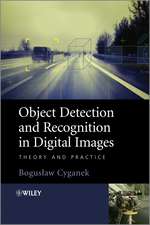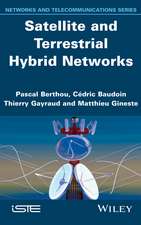Position, Navigation, and Timing Technologies in the 21st Century –Integrated Satellite Navigation, Sensor Systems, and Civil Applications Volume 2
Autor M. Mortonen Limba Engleză Hardback – 8 feb 2021
Preț: 1063.53 lei
Preț vechi: 1381.21 lei
-23% Nou
Puncte Express: 1595
Preț estimativ în valută:
203.50€ • 213.05$ • 168.39£
203.50€ • 213.05$ • 168.39£
Carte disponibilă
Livrare economică 17-31 martie
Preluare comenzi: 021 569.72.76
Specificații
ISBN-13: 9781119458494
ISBN-10: 1119458498
Pagini: 896
Dimensiuni: 213 x 287 x 47 mm
Greutate: 1.91 kg
Ediția:Volume 2
Editura: Wiley
Locul publicării:Hoboken, United States
ISBN-10: 1119458498
Pagini: 896
Dimensiuni: 213 x 287 x 47 mm
Greutate: 1.91 kg
Ediția:Volume 2
Editura: Wiley
Locul publicării:Hoboken, United States
Notă biografică
Y. JADE MORTON, PHD is a Professor at Ann and H. J. Smead Aerospace Engineering Sciences Department, University of Colorado at Boulder. Her research interests lie at the intersection of satellite navigation and remote sensing of the space environment, atmosphere, and Earth surface. She has led numerous research projects sponsored by AFOSR, AFRL, DARPA, NASA, NSF, ONR, and private industries. Dr. Morton is the President of the Institute of Navigation (ION), a fellow of IEEE, ION, and the Royal Institute of Navigation (RIN, UK).
FRANK VAN DIGGELEN, PHD is a Principal Engineer at Google, where he leads the Android Core-Location Team. He also teaches at Stanford University. He is the inventor of coarse-time GNSS navigation, co-inventor of Long Term Orbits for A-GNSS, and the author of "A-GPS" the first textbook on Assisted GNSS. He is Executive Vice President of the Institute of Navigation (ION) and a Fellow of the ION and the Royal Institute of Navigation (UK).
JAMES J. SPILKER, JR., PHD was a Consulting Professor in the Aeronautics and Astronautics Department at???Stanford University. Dr. Spilker was an elected member of the National Academy of Engineering, a Life Fellow of the IEEE, and a Fellow of the Institute of Navigation (ION). As one of the originators of GPS, James Spilker shared the Goddard Memorial Trophy and the Queen Elizabeth Prize for Engineering.
BRADFORD W. PARKINSON, PHD is an Edward C. Wells Professor of Aeronautics and Astronautics Emeritus at Stanford University. Dr. Parkinson was the Chief Architect for GPS, led the original advocacy and development for the system, and served as the first Director of the GPS Joint Program Office. He has been the CEO of two companies and serves on many boards. Among his many awards are the IEEE Medal of Honor, the Draper Prize of the National Academy of Engineering, and the Queen Elizabeth Prize for Engineering.
Cuprins
Part D: Position, Navigation, and Timing Using Radio Signals-of-Opportunity
35. Overview of Volume 2: Integrated PNT Technologies and Applications
John F. Raquet, Air Force Institute of Technology, US
36. Non-Linear Recursive Estimation for Integrated Navigation Systems
Michael J. Veth, Veth Research Associates, US
37. Overview of Indoor Navigation Techniques
Sudeep Pasricha, Colorado State University, US
38. Navigation with Cellular Signals-of-Opportunity
Zak Kassas, University of California Irvine, US
39. Navigation with Dedicated Metropolitan Beacon Systems
Subbu Meiyappan, NextNav LLC, US
Arun Raghupathy, NextNav LLC, US
Ganesh Pattabiraman, NextNav LLC, US
40. Navigation with Terrestrial Digital Broadcast Signals
Chun Yang, SigTem Technology Inc., US
41. Navigation with Low Frequency Radio Signals
Wouter Pelgrum, Blue Origin, US
Charles Schue, III, Ursa Nav., US
42. Adaptive Radar Navigation System
Kyle Kauffman, Air Force Institute of Technology, US
43. Navigation from Low Earth Orbit
Tyler G. R. Reid, Stanford University., US
Todd Walter, Stanford University, US
Per Enge, Stanford University, US
David Lawrence, Satelles, US
H. Stewart Cobb, Satelles, US
Greg Gutt, Satelles, US
Michael O'Conner, Satelles, US
David Whelan, University of California San Diego, US
Part E: Position, Navigation, and Timing Using Non-Radio Signals-of-Opportunity
44. Inertial Navigation Sensors
Stephen Smith, Draper Laboratory, US
45. MEMS Inertial Sensors
Alissa M. Fitzgerald, A.M. Fitzgerald & Associates, LLC, US
46. GNSS-INS Integration
Andrey Soloviev, QuNav, US
James L. Farrell, Vigil Inc., US
Maarten Uijt de Haag, Ohio University, US
47. Atomic Clock for GNSS
Leo Hollberg, Stanford University, US
48. Positioning Using Magnetic Fields
Aaron Canciani, Air Force Institute of Technology, US
John F. Raquet, Air Force Institute of Technology, US
49. Laser-Based Navigation
Maarten Uijt de Haag, Ohio University
Zhen Zhu, East Carolina University, US
Jacob Campbell, Air Force Research Laboratory, US
50. Image-Aided Navigation - Concept and Applications
Michael J. Veth, Veth Research Associates, US
John F. Raquet, Air Force Institute of Technology, US
51. Digital Photogrammetry
Charles Toth, the Ohio State University, US
Zoltan Koppanyi, the Ohio State University, US
52. Navigation Using Pulsars and Other Variable Celestial Sources
Suneel Sheikh, ASTER Labs, Inc., US
53. Neuroscience of Navigation
Meredith E. Minear, University of Wyoming, US
Tes K. Sensibaugh, University of Wyoming, US
54. Orientation and Navigation in the Animal World
Gillian Durieux, Max Plank Institute for Evolutionary Biology, Germany
Miriam Liedvogel, Max Plank Institute for Evolutionary Biology, Germany
Part F: Position, Navigation, and Timing for Consumer and Commercial Applications
55. GNSS Applications in Surveying and Mobile Mapping
Naser El-Sheimy, University of Calgary, Canada
Zahra Lari, University of Calgary, Canada
56. Precision Agriculture
Arthur F. Lange, Trimble Navigation, US
John Peake, Trimble Navigation, US
57. Wearables
Mark Gretton, TomTom, US
Peter Franks Pauwels, TomTom, US
58. Navigation in Advanced Driver-Assisted Systems and Automated Driving
David Bevly, Auburn University, US
Scott Martin, Auburn University, US
59. Train Control and Rail Traffic Management Systems
Alessandro Neri, University of Roma TRE, Italy
60. Commercial Unmanned Aircraft Systems
Maarten Uijt de Haag, Ohio University, US
Evan Dill, National Aeronautics and Space Administration, US
Steven D. Young, National Aeronautics and Space Administration, US
Mathieu Joerger, Virginia Tech, US
61. Navigation for Aviation
Sherman Lo, Stanford University, US
62. Orbit Determination with GNSS
Yoaz Bar-Sever, Jet Propulsion Lab, US
63. Satellite Formation Flying and Rendezvous
Simone D'Amico, Stanford University, US
J. Russell Carpenter, National Aeronautics and Space Administration, US
64. Navigation in the Arctic
Tyler G. R. Reid, Stanford University, US
Todd Walter, Stanford University, US
Robert Guinness, Finnish Geospatial Research Institute, Finland
Sarang Thombre, Finnish Geospatial Research Institute, Finland
Heidi Kuusniemi, Finnish Geospatial Research Institute, Finland
Norvald Kjerstad, Norwegian University of Science and Technology, Norway
















